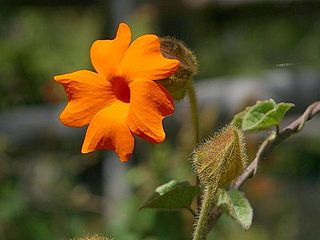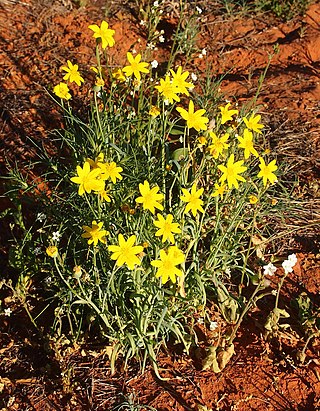
Adansonia gregorii, commonly known as the boab and also known by a number of other names, is a tree in the family Malvaceae, endemic to the northern regions of Western Australia and the Northern Territory of Australia.

Sir Augustus Charles Gregory was an English-born Australian explorer and surveyor. Between 1846 and 1858 he undertook four major expeditions. He was the first Surveyor-General of Queensland. He was appointed a lifetime Member of the Queensland Legislative Council.
Birger Gregersson was Archbishop of Uppsala from 1366 until his death 1383.

Thunbergia is a genus of flowering plants in the family Acanthaceae, native to tropical regions of Africa, Madagascar and southern Asia. Thunbergia species are vigorous annual or perennial vines and shrubs growing to 2–8 m tall. The generic name honours the Swedish naturalist Carl Peter Thunberg (1743-1828).

Peter Schöffer or Petrus Schoeffer was an early German printer, who studied in Paris and worked as a manuscript copyist in 1451 before apprenticing with Johannes Gutenberg and joining Johann Fust, a goldsmith, lawyer, and money lender.

Nicrosaurus (/nɪkroʊˈsɔrəs/) is an extinct genus of phytosaur reptile existing during the Late Triassic period. Although it looked like a crocodile, it was not closely related to these creatures, instead being an example of parallel evolution. The main difference between Nicrosaurus and modern crocodiles is the position of the nostrils – Nicrosaurus's nostrils, or external nares, were placed directly in front of the forehead, whereas in crocodiles, the nostrils are positioned on the end of the snout. A 2013 study has also found that ilium of Nicrosaurus is quite distinctive from all other phytosaurs.
Polarornis is a genus of prehistoric bird, possibly an anserimorph. It contains a single species Polarornis gregorii, known from incomplete remains of one individual found on Seymour Island, Antarctica, in rocks which are dated to the Late Cretaceous.

The Decretals of Gregory IX, also collectively called the Liber extra, are a source of medieval Catholic canon law. In 1230, Pope Gregory IX ordered his chaplain and confessor, Raymond of Penyafort, a Dominican, to form a new canonical collection destined to replace the Decretum Gratiani, which was the chief collection of legal writings for the church for over 90 years. It has been said that the pope used these letters to emphasize his power over the Universal Church.

Dromomeron is a genus of lagerpetid avemetatarsalian which lived around 220 to 211.9 ± 0.7 million years ago. The genus contains species known from Late Triassic-age rocks of the Southwestern United States and northwestern Argentina. It is described as most closely related to the earlier Lagerpeton of Argentina, but was found among remains of true dinosaurs like Chindesaurus, indicating that the first dinosaurs did not immediately replace related groups.

The pinworm, also known as threadworm or seatworm, is a parasitic worm. It is a nematode (roundworm) and a common intestinal parasite or helminth, especially in humans. The medical condition associated with pinworm infestation is known as pinworm infection (enterobiasis) or less precisely as oxyuriasis in reference to the family Oxyuridae.
Redondasaurus is an extinct genus or subgenus of phytosaur from the Late Triassic of the southwestern United States. It was named by Hunt & Lucas in 1993, and contains two species, R. gregorii and R. bermani. It is the youngest and most evolutionarily-advanced of the phytosaurs.

Leptosuchus is an extinct genus of leptosuchomorph phytosaur with a complex taxonomical history. Fossils have been found from the Dockum Group and lower Chinle Formation outcropping in Texas, New Mexico, and Arizona, USA, and date back to the Carnian stage of the Late Triassic.
Gregori's labeo is fish in genus Labeo. It is found in the Tana and Galana Rivers in Kenya and Tanzania. IUCN reports it also from Juba, Somalia, and does not include Tanzania in the distribution area.

Brachychiton gregorii, commonly known as the desert kurrajong, is a small tree of the genus Brachychiton found in northern and western Australia. It was originally classified in the family Sterculiaceae, which is now within Malvaceae.
Pravusuchus is an extinct genus of leptosuchomorph parasuchid phytosaur known from the Late Triassic of Arizona, United States. It contains a single species, Pravusuchus hortus, which is known from three specimens. These specimens were previously referred to Smilosuchus or to Leptosuchus, but Pravusuchus's autapomorphy, its phylogenetic position as well as a trait shared with mystriosuchins, justified the erection of a new taxon for the material.
Protomocerus is a genus of longhorn beetles of the subfamily Lamiinae, containing the following species:

Thunbergia gregorii, commonly known as orange clockvine or orange trumpet vine, is a herbaceous perennial climbing plant species in the family Acanthaceae, native to East Africa and sometimes cultivated as an ornamental vine. The bright, pure all-orange flowers distinguish it from the related black-eyed Susan vine.
Giovanni and GregorioDe' Gregori were two Italian brothers from Forlì who worked as printers in Renaissance Venice. They are generally credited with the first attractive type in nonpareil size for a 1498 or 1501 edition of the divine offices.
Protomocerus pulcher is a species of beetle in the family Cerambycidae. It was described by Péringuey in 1892.

Senecio gregorii, commonly known as annual yellowtop or fleshy groundsel, is a native Australian wildflower species, found in arid and semi-arid regions of the Australia and across the globe. It often grows prolifically after autumn/winter rains, showcasing stunning yellow flowers and fleshy foliage. The scientific name of this species was first published by Ferdinand von Mueller.











